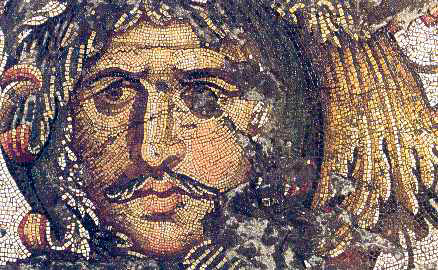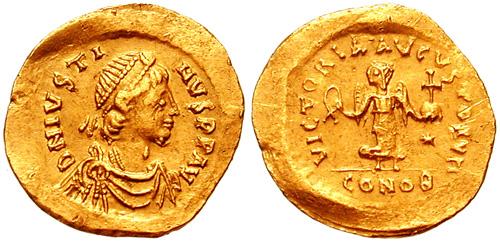|
Euphemia (empress)
Euphemia (Greek: Εὐφημία, died 523 or 524), born Lupicina, was an Empress of the Eastern Roman Empire by marriage to Justin I. Empress Euphemia is credited with the ecclesiastical policies of Justin and she founded a Church of Saint Euphemia, where she was buried following her death, probably in either 523 or 524. Justin was buried by her side in 527. Early life Her original name was Lupicina, according to Procopius and Victor of Tunnuna. According to the ''Secret History'' of Procopius, Lupicina was both a slave and a barbarian. He asserted that she had been the concubine of her owner.Procopius, "Secret History", Chapter 6.17 The information from the ''Secret History'' was published posthumously. The seven volumes of histories that were published in his lifetime were ... [...More Info...] [...Related Items...] OR: [Wikipedia] [Google] [Baidu] |
Augusta (honorific)
Augusta may refer to: Places Australia * Augusta, Western Australia Brazil * Rua Augusta (São Paulo) Canada * Augusta, Ontario * North Augusta, Ontario * Augusta Street (Hamilton, Ontario) France * Augusta Suessionum ("Augusta of the Suessii"), Soissons * Augusta Viromanduorum ("Augusta of the Viromandui"), Saint-Quentin Germany * Augusta Treverorum ("Augusta of the Treveri") or Trier * Augusta Vangionum ("Augusta of the Vangiones") or Worms * Augusta Vindelicorum ("Augusta of the Vindelici") or Augsburg Italy * Augusta, Sicily * Augusta Praetoria Salassorum ("Praetorian Augusta of the Salassi") or Aosta * Augusta Taurinorum ("Augusta of the Taurini") or Turin * Perugia or ''Augusta Perusia'' Spain * Emerita Augusta, Mérida, Spain * Caesar Augusta, Zaragoza, Spain United States * Augusta, Arkansas * Augusta Charter Township, Michigan * Augusta County, Virginia * Augusta, Georgia ** Augusta National Golf Club ("Augusta"), home of the Masters Tournament * Au ... [...More Info...] [...Related Items...] OR: [Wikipedia] [Google] [Baidu] |
Concubinage
Concubinage is an interpersonal relationship, interpersonal and Intimate relationship, sexual relationship between two people in which the couple does not want to, or cannot, enter into a full marriage. Concubinage and marriage are often regarded as similar, but mutually exclusive. During the early stages of European colonialism, administrators often encouraged European men to practice concubinage to discourage them from paying prostitutes for sex (which could spread venereal disease) and from homosexuality. Colonial administrators also believed that having an intimate relationship with a native woman would enhance white men's understanding of native culture and would provide them with essential domestic labor. The latter was critical, as it meant white men did not require wives from the metropole, hence did not require a family wage. Colonial administrators eventually discouraged the practice when these liaisons resulted in offspring who threatened colonial rule by producing a m ... [...More Info...] [...Related Items...] OR: [Wikipedia] [Google] [Baidu] |
Great Palace Of Constantinople
The Great Palace of Constantinople (, ''Méga Palátion''; ), also known as the Sacred Palace (, ''Hieròn Palátion''; ), was the large imperial Byzantine palace complex located in the south-eastern end of the peninsula today making up the Fatih district of Istanbul (formerly Constantinople), in modern Turkey. It served as the main imperial residence of the Eastern Roman emperors until 1081 and was the centre of imperial administration for over 690 years. Only a few remnants and fragments of its foundations have survived into the present day. History When Constantine I (emperor), Constantine I refounded Byzantium as Constantinople in 330, he planned out a palace for himself. The palace was located between the Hippodrome of Constantinople, Hippodrome and Hagia Sophia. The complex of palaces was rebuilt and expanded several times during its history. Much of the complex was destroyed during the Nika riots of 532 and was rebuilt lavishly by the emperor Justinian I. Further extens ... [...More Info...] [...Related Items...] OR: [Wikipedia] [Google] [Baidu] |
Ecumenical Patriarch Of Constantinople
The ecumenical patriarch of Constantinople () is the List of ecumenical patriarchs of Constantinople, archbishop of Constantinople and (first among equals) among the heads of the several autocephalous churches that comprise the Eastern Orthodox Church. The ecumenical patriarch is regarded as the representative and spiritual leader of the Eastern Orthodox Christians worldwide. The term ''ecumenical'' in the title is a historical reference to the Ecumene, a Greek designation for the civilised world, i.e. the Roman Empire, and it stems from Canon 28 of the Council of Chalcedon. The patriarch's Episcopal see, see, the Ecumenical Patriarchate of Constantinople, is one of the most enduring institutions in the world and has had a prominent part in world history. The ecumenical patriarchs in ancient times helped in the spread of Christianity and the resolution of various doctrinal disputes. In the Middle Ages, they played a major role in the affairs of the Eastern Orthodox Church, as w ... [...More Info...] [...Related Items...] OR: [Wikipedia] [Google] [Baidu] |
John Of Cappadocia
John of Cappadocia, surnamed ''Cappadox'' or ''the Cappadocian'' ( Greek: Ἰωάννης ὁ Καππαδόκης; died February 520), was patriarch of Constantinople in 518–520, during the reign of Byzantine emperor Anastasius I Dicorus after an enforced condemnation of the Council of Chalcedon. His short patriarchate is memorable for the celebrated Acclamations of Constantinople, and the reunion of East and West after a schism of 34 years. At the death of Timothy I of Constantinople, John of Cappadocia, whom he had designated his successor, was presbyter and chancellor of the Church of Constantinople. Biography On 9 July 518, the long reign of Anastasius I Dicorus came to a close, the orthodox Justin I succeeding. On 15 July, the new emperor entered the cathedral, and the patriarch, accompanied by twelve prelates, was making his way through the throngs that crowded every corner. As he came near the raised dais where the pulpit stood shouts arose, "Long live the pat ... [...More Info...] [...Related Items...] OR: [Wikipedia] [Google] [Baidu] |
Scholae Palatinae
The ''Scholae Palatinae'' (; ) were an elite military imperial guard unit, usually ascribed to the Roman Emperor Constantine the Great as a replacement for the '' equites singulares Augusti'', the cavalry arm of the Praetorian Guard. The ''Scholae'' survived in Roman and later Byzantine service until they disappeared from the historical record in the late 11th century, during the reign of Alexios I Komnenos. 4th–7th centuries: imperial guards History and structure During the early 4th century, '' Caesar'' Flavius Valerius Severus attempted to disband the remaining units of the Praetorian Guard on the orders of Galerius. In response, the Praetorians turned to Maxentius, the son of the retired emperor Maximian, and proclaimed him their emperor on 28 October 306. When Constantine the Great (), launching an invasion of Italy in 312, forced a final confrontation at the Milvian Bridge, the Praetorian cohorts made up the most prominent element of Maxentius' army. Later, in Rom ... [...More Info...] [...Related Items...] OR: [Wikipedia] [Google] [Baidu] |
Magister Officiorum
The (Latin; ; ) was one of the most senior administrative officials in the Later Roman Empire and the early centuries of the Byzantine Empire. In Byzantium, the office was eventually transformed into a senior honorary rank, simply called ''magistros'' (μάγιστρος), until it disappeared in the 12th century. History and functions Late Roman Empire Although some scholars have supported its creation under Emperor Diocletian (), the office can first be definitely traced to the year 320, during the reign of Roman emperor Constantine the Great (), but was probably created sometime soon after 312–13, probably as part of an effort to limit the power of the praetorian prefect (''praefectus praetorio'') the Roman emperor's chief administrative official. The ''magister'' was first given command of the palace guard, the '' Scholae Palatinae''. He was also appointed head of the palatine secretariats, divided into four bureaux, the ''sacra scrinia'', each under a respective ''magist ... [...More Info...] [...Related Items...] OR: [Wikipedia] [Google] [Baidu] |
Celer (magister Officiorum)
Flavius Celer () was a Byzantine general and ''magister officiorum'' under Emperor Anastasius (r. 491–518) in the early 6th century. Biography Celer was an Illyrian though nothing is known of his early life. In 503, Emperor Anastasius named him general in the ongoing war against the Sassanid Persians in the East. In the spring of 504, he led his men to participate in the ongoing siege of Amida, but soon after left and engaged in an invasion of Persian-held territory, retaking several cities and returning with much booty. In late 504, Celer engaged in negotiations with the Persians, which resulted in a temporary truce.. In 505, he was again active on the eastern frontier, but is not reported to have engaged in major operations; he did, however, continue contacts with the Persians, ransoming Amida for 1,100 pounds of gold. In autumn 506, Celer led the Byzantine negotiations with the Persians at Dara, which resulted in the conclusion of a peace treaty. Perhaps as a reward, he was na ... [...More Info...] [...Related Items...] OR: [Wikipedia] [Google] [Baidu] |
Silentiarius
''Silentiarius'', Hellenized to ''silentiarios'' () and Anglicized to silentiary, was the Latin title given to a class of courtiers in the Byzantine imperial court, responsible for order and silence () in the Great Palace of Constantinople. In the middle Byzantine period (8th–11th centuries), it was transformed into an honorific court title. History and functions An imperial edict dated to 326 or 328 provides the earliest attestation of the title.. The '' schola'' of the ''silentiarii'' was supervised by the '' praepositus sacri cubiculi'' and its members belonged to the jurisdiction of the ''magister officiorum''. Their function in the palace was to keep order during imperial audiences and to call the meeting of the emperor's privy council, the '' consistorium'' (an act called "''silentium nuntiare''").. Four ''silentiarii'' were detailed to the service of the empress. The ''silentiarii'' were chosen from the senatorial class, but freed from the usual obligations of this class. ... [...More Info...] [...Related Items...] OR: [Wikipedia] [Google] [Baidu] |
Excubitors
The Excubitors ( or , , i.e. 'sentinels'; transcribed into Greek as , ) were founded in as an imperial guard-unit by the Byzantine emperor Leo I the Thracian. The 300-strong force, originally recruited from among the warlike mountain tribe of the Isaurians, replaced the older as the main imperial bodyguards. The Excubitors remained an active military unit for the next two centuries, although, as imperial bodyguards, they did not often go on campaign. Their commander, the Count of the Excubitors (, ), soon acquired great influence. Justin I was able to use this position to rise to the throne in 518, and thereafter the Counts of the Excubitors were among the main political power-holders of their day; two more, Tiberius II Constantine and Maurice, rose to become emperors in the late 6th century. In the later part of the 7th century the Excubitors appear to have morphed into a parade-ground formation, and they fade from the record as a corps. Individual seals of office suggest ... [...More Info...] [...Related Items...] OR: [Wikipedia] [Google] [Baidu] |
Comes Excubitorum
The Excubitors ( or , , i.e. 'sentinels'; transcribed into Greek language, Greek as , ) were founded in as an imperial guard-unit by the Byzantine emperor Leo I the Thracian. The 300-strong force, originally recruited from among the warlike mountain tribe of the Isaurians, replaced the older as the main imperial bodyguards. The Excubitors remained an active military unit for the next two centuries, although, as imperial bodyguards, they did not often go on campaign. Their commander, the Count of the Excubitors (, ), soon acquired great influence. Justin I was able to use this position to rise to the throne in 518, and thereafter the Counts of the Excubitors were among the main political power-holders of their day; two more, Tiberius II Constantine and Maurice (emperor), Maurice, rose to become emperors in the late 6th century. In the later part of the 7th century the Excubitors appear to have morphed into a parade-ground formation, and they fade from the record as a corps. Indiv ... [...More Info...] [...Related Items...] OR: [Wikipedia] [Google] [Baidu] |




